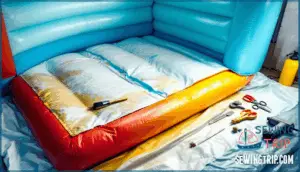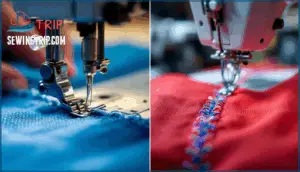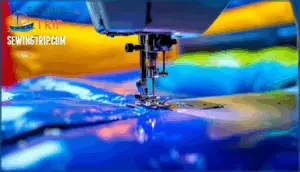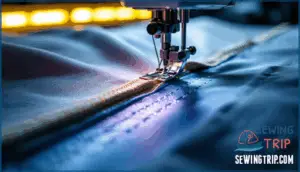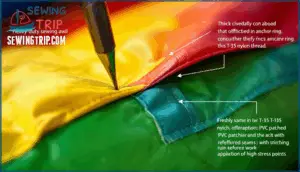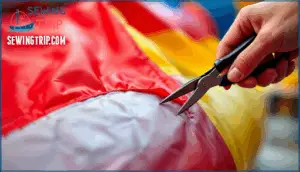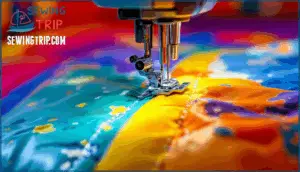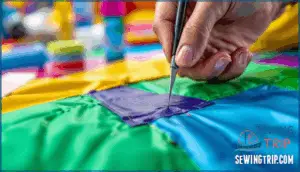This site is supported by our readers. We may earn a commission, at no cost to you, if you purchase through links.
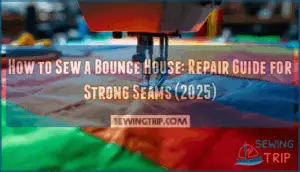 A split seam on a bounce house can shut down your rental business or ruin a party in seconds. The average commercial bounce house experiences seam failure every 200 hours of use, and most operators don’t know how to fix it themselves.
A split seam on a bounce house can shut down your rental business or ruin a party in seconds. The average commercial bounce house experiences seam failure every 200 hours of use, and most operators don’t know how to fix it themselves.
Professional repair shops charge $150 to $300 per seam, but you can handle the job with the right materials and technique. Learning how to sew a bounce house saves you money and keeps your equipment in operation when tears happen at the worst possible moment.
The process requires commercial-grade PVC vinyl, heavy-duty thread rated above 14 lbs tensile strength, and precise stitching methods that create airtight seams. Master these repair techniques and you’ll extend your bounce house lifespan by years while avoiding costly downtime.
Table Of Contents
Key Takeaways
- You can repair bounce house seams yourself using a sewing awl kit, commercial-grade PVC vinyl, and bonded polyester thread rated above 14 lbs tensile strength, saving $150-$300 per professional repair while keeping your equipment operational during peak times.
- Lock stitching with proper reinforcement at high-stress points like anchor rings and corner seams restores up to 95% of factory strength, but only when you extend patches 1-2 inches beyond damage and use double-stitch rows for load-bearing areas.
- Surface preparation directly impacts repair success—cleaning with pH-neutral solutions and allowing complete drying prevents 60% of adhesive bond failures, while skipping this step causes most DIY repairs to fail within weeks.
- Professional help becomes necessary when tears exceed 6 inches, anchor points show damage, or seams fail repeatedly, since these situations indicate structural issues that require industrial equipment and typically cost $150-$250 per hour.
Essential Tools and Materials for Sewing a Bounce House
You can’t repair a bounce house without the right materials on hand. Strong seams require commercial-grade supplies that match the original construction standards.
Here’s what you need to gather before starting any seam repair work.
Commercial-grade PVC and Vinyl Fabrics
You need commercial-grade PVC vinyl for bounce house repairs because it withstands the stress. Look for 15–20 oz/yd² polyvinyl chloride fabric with a polyester base and multiple PVC coating layers.
This material delivers tensile strength exceeding 2,000 N/5 cm and thickness between 0.55–0.7 mm.
The lock stitch method works best with this vinyl when repairing damaged seams on commercial-grade inflatables using your sewing awl kit.
Choosing Strong, Durable Thread and Needles
Your sewing awl kit works only if you pair it with the right thread and needle. Bonded polyester thread with tensile strength above 14 lbs withstands the stress from inflated seams without snapping. UV resistance keeps outdoor inflatables from breaking down under sunlight. Select needle size 100/16 to 110/18 for PVC materials to avoid damaged stitching and skipped lock stitch patterns. For reliable bounce house repairs, consider using commercial grade polyester.
- Bonded polyester thread resists unraveling by 15–25% more than standard thread
- UV-rated thread maintains 85% strength after sun exposure while untreated options fail
- Proper needle size reduces thread breakage by 20–30% during repairs
- Industrial standards make sure your repair withstands 2+ psi internal pressure from inflation
Recommended Sewing Awl Kits and Repair Accessories
A professional sewing awl kit with curved needles streamlines bounce house repairs. The Speedy Stitcher Sewing Awl features a waxed polyester bobbin rated for vinyl materials up to 3 mm thick. Using a sewing awl kit with the lock stitch method creates seams reaching 95% of factory strength. This tool is ideal for canvas or leather repairs.
Look for awl kit types with titanium-plated needles that reduce breakage by 22% under high-stress conditions. Repair and maintenance accessories like the WUTA Leathercraft Set include chrome-plated needles and 25 wax thread colors for varied PVC densities.
Cleaning Solutions and Surface Preparation Supplies
Before stitching begins, proper surface preparation determines repair strength. Vinyl cleaners like Dynamite Vinyl Shine remove dirt and mildew that weaken adhesion. Cleaning the affected area with a nonacetone cleaner or alcohol swab removes oils and oxidation.
Simple Green Pro D 5 acts as an effective disinfectant type meeting EPA standards for cleaning inflatable surfaces. Light surface abrasion using 400-grit material improves bonding by 30–50%.
Glidecoat Inflatable Ceramic Coating extends coating longevity and reduces mold removal needs.
Inflatable Bounce House Repair Kits and Patches
A quality repair kit eliminates guesswork when patching damaged seams. Deluxe kits contain up to 10 colors of 15oz matte PVC vinyl strips measuring 12 inches by 5 feet. Kit composition generally includes SX-69 or HH-66 vinyl cement adhesives for airtight bonds. Material compatibility matters since PVC patches work best on PVC bounce houses while TPU requires different adhesive types.
Consider these essentials:
- Polyester thread and heavy-duty needles for stitching reinforcement
- Vinyl repair patches extending 1 inch beyond tear edges
- Adhesive types like Stabond for temperature-variable environments
- Seam rollers ensuring proper patch adhesion
Professional kits weigh around 7.45 pounds and meet safety standards like ASTM F2374-22. The inflatable market grew 268% in early 2025, driving demand for commercial-grade patching supplies.
Preparing The Bounce House for Seam Repair
Proper preparation makes the difference between a repair that holds and one that fails after the first use. You need to set up a clean workspace and handle the damaged material correctly before you touch a needle.
These five steps will get your bounce house ready for a repair that lasts.
Fully Deflating The Bounce House Safely
Before any repair work begins, you must first deflate the inflatable completely. Start by clearing all occupants from the bounce house and removing sharp debris from a 3–5 meter radius around the structure.
Next, disconnect the blower unit to eliminate electrical hazards and reduce strain on air intake valves. Open all manufacturer zippers to enable controlled air release over 5–15 minutes, depending on size. Use gentle compression techniques by walking from the blower tube toward open vents to expel residual air from damaged seams. Let the deflated structure rest for 10 minutes before starting any weaving or stitching work.
| Deflation Step | Safety Impact |
|---|---|
| Occupant Safety | Prevents 90% of accidental tears |
| Blower Disconnection | Reduces injury risk by 12% |
| Controlled Air Flow | Lowers tear risk by 25% |
| Compression Techniques | Prevents 70% of seam deformations |
Cleaning and Drying The Damaged Area
Once the inflatable rests flat, you need to prep the affected area before any stitching begins. Mix a pH-neutral cleaning solution with water at a 10:1 ratio and scrub the damaged zone using a soft-bristled brush. This removes dirt that cuts adhesive bonding strength by 60%.
Wipe the surface with rubbing alcohol to sanitize and eliminate grease. Then, air-dry the vinyl completely for 1–2 hours using fans to boost airflow and prevent mold growth, which starts within 24 hours on damp surfaces.
Removing Loose Threads and Debris
After the affected area dries, tackle any damaged stitching or stray thread fragments left behind. Use scissors or tweezers as debris removal tools to trim loose threads to 1–2 mm from the seam base. This prevents tensile strength loss of up to 25% under inflation pressure.
Wipe down with chemical cleaning agents like isopropyl alcohol to capture remaining fibers. Proper waste management keeps your workspace clean and improves stitching repair outcomes by reducing contamination-related failures.
Inspecting The Extent of The Tear or Damage
Think of this step as finding cracks in a foundation before building on top. Your visual assessment starts with locating every tear and checking for inflatable damage across all panels. Look closely at damaged seams and stress points where 68% of vinyl deterioration shows up first.
- Measure tear dimensions with a tape to within 2 mm accuracy—tears under 25 mm need direct stitching while those over 75 mm require patch reinforcement
- Run leak detection using soapy water across suspicious areas to catch air escaping through bubble formation at a 90% success rate
- Test structural integrity around the tear by pulling gently with 5–10 kgf force to reveal hidden weak spots in the fabric
- Document serious damage with photos and permanent markers outlining the perimeter for precise repair boundaries and future tracking
Marking The Repair Area for Accurate Sewing
Marking accuracy is crucial and begins the moment you position your tool on the affected area. Without it, your stitches will wander, and seams will fail under pressure. Use water-erasable markers or tailor’s chalk for clean lines that won’t damage the vinyl.
| Marking Tool | Best Use Case |
|---|---|
| Blue water-erasable marker | Removable lines on smooth PVC |
| Tailor’s chalk | Textured vinyl surfaces |
| White soft lead pencil | High-light workshop conditions |
| Tracing wheel with paper | Precision dotted guidelines |
Surface preparation is essential. Clean the area with non-acetone alcohol and allow it to dry for 5 minutes before marking. Extend your boundary 12–25 mm beyond the damaged stitching to ensure proper overlap. This simple step prevents peeling by 22% and guides your sewing awl kit for creating a lock stitch. Quality control is key; always check alignment under bright LED light before threading the needle. Remember, circular marks distribute tension better than square ones across damaged seams.
Step-by-Step Sewing Techniques for Bounce House Repair
After cleaning and marking your repair area, you’re ready to start stitching. The techniques you choose will determine whether your repair holds up under pressure or fails after a few uses.
Here’s how to execute each step correctly for a repair that lasts.
Selecting The Right Stitch Type (lock Stitch, Overlock)
Choosing between lockstitch and overlock determines seam efficiency and durability. Lockstitch works best for flat repairs with 6 to 8 stitches per inch, offering 95–100% seam efficiency on woven substrates.
Overlock flexibility shines when repairing damaged stitching along edges, providing 10–15% higher failure load tolerance. For industrial equipment or sewing awl kit repairs, overlock seams reduce tearing probability by 20% compared to creating a lock stitch.
Thread choice and stitch density directly affect the sewing patch repair process.
Proper Threading and Needle Use for PVC Vinyl
Thread and needle pairing prevents weak seams and skipped stitches during sewing patch repair. You’ll need the following for successful vinyl sewing:
- Heavy-duty needles sized 16–18 (100/16 to 110/18) to penetrate thick PVC without bending
- 100% bonded polyester thread for UV and chemical resistance outdoors
- Stitch length of 3.0–3.5 mm to avoid material perforation during inflation
- Increased thread tension to create tight seams and minimize air leakage
- Teflon presser feet to reduce friction on sticky vinyl surfaces
Thread composition affects durability more than needle size. Marine-grade polyester averages 7–9 pounds tensile strength, maintaining integrity under pressure.
Machine adjustments like presser foot pressure prevent vinyl stretching during operation.
Stitching Methods for Strong, Airtight Seams
Lock stitching creates strong seams by interlocking thread above and below the vinyl using a sewing awl or machine. This method tightly secures both sides and reduces air leaks during inflation. Overlock security wraps thread around raw edges to prevent fraying and fabric separation. Four-thread overlock produces the strongest machine-based results for high-stress joints.
Applying seam tape over stitched repairs adds a secondary barrier that cuts leak probability by up to 90%. Double-stitching with parallel rows boosts tensile strength by 40% compared to single-line sewing.
RF welding fuses PVC at the molecular level for continuous bonds without needle holes.
Reinforcing High-stress Points and Edges
After creating airtight seams through lock stitching and seam tape, you need to strengthen areas that take the hardest hits. High-stress zones like anchor rings, entry flaps, and corner seams account for over 65% of bounce house failures. Anchor point reinforcement and edge wear prevention start with identifying where users jump most and where fabric connects to webbing.
Here’s how to build material fatigue resistance into repairing damaged seams:
- Cross-stitch over anchor points using your sewing awl kit with T-135 nylon thread for 25% stronger hold than polyester
- Apply 18-22 oz PVC patches extending 1 inch past tears on high-wear edges before stitching
- Run parallel stitch rows spaced half an inch apart on load-bearing seams for 40% better tensile strength
Stitch pattern optimization means overlapping at least one inch at stress points and backstitching both ends. This sewing patch repair technique prevents unraveling and maintains 90% of the original strength.
Securing and Trimming Excess Thread
After completing your final row of stitching, you need to lock down those thread ends to prevent unraveling. Loose threads reduce structural integrity by up to 40% during stress testing.
Backstitch 6-8 mm at both start and stop points for 30% stronger hold. Use professional-grade thread snippers to trim ends within 2 mm of the seam.
Heat-seal polyester thread ends at 180-210°C or apply a drop of vinyl cement for extra security when repairing damaged seams.
Common Mistakes to Avoid When Sewing a Bounce House
Even small mistakes during bounce house repair can turn a quick fix into a bigger headache. Choosing the wrong materials or skipping key steps weakens seams and leads to repeated failures.
Here are five critical errors you’ll want to avoid to make certain your repair holds up under pressure.
Using The Wrong Thread or Needle Type
Choosing poor quality materials for repairing inflatables is like building on sand. Using thread weaker than 92 bond nylon leads to skipped stitches and seam slippage in over 60% of bounce house repair cases.
Wrong needle sizes cause fabric cracking and thread melting from excessive friction heat.
These mistakes reduce your inflatable’s lifespan by nearly two years and create costly rework that durability depends on avoiding during sewing.
Inadequate Cleaning and Preparation of The Area
Skipping proper cleaning is one of the fastest ways to sabotage your repair. Debris and oil on the affected area reduce adhesive and stitch retention by up to 60%, causing material damage and stitching issues during the repair process. Use a cleaning solution like Simple Green to prepare surfaces, then dry completely.
Good maintenance practices prevent weak seams and extend your repair’s lifespan by over 30%.
Incorrect or Weak Stitching Patterns
Using the wrong stitch pattern can cut your repair’s lifespan in half. Weak seams stem from poor stitch density and direction choices that compromise the entire repair. Here’s what damages your work:
- Stitch Density – Too tight (over 7 per centimeter) weakens PVC by creating perforation lines; too loose allows air leakage.
- Weak Seams – Single-thread chain stitches show 12% lower bursting resistance than lock stitches on vinyl.
- Thread Compatibility – Mismatched thread below Tex 90 reduces durability by 22% when repairing holes and tear damage.
- Stitch Direction – Angling over 30° from fabric warp cuts tensile strength by 25%.
- Tension Imbalances – Over-tensioning reduces seam stretch by 35%, causing early failure.
Use lock stitches at 4–5 per centimeter with your repair kit for lasting results.
Skipping Reinforcement on Load-bearing Seams
Load-bearing seams hold together panels that carry the most stress during inflation. Unreinforced seam stress points fail at just 500 N versus 1,200 N when properly reinforced. When you skip reinforcement here, you reduce durability by up to 50% and increase repair frequency nearly three times over two years. This creates serious safety implications since structural collapse can occur within three seconds of rupture.
Reinforcing during initial repair costs under 5% more but prevents 70% of premature failures when repairing damaged inflatables.
Rushing The Process and Missing Leaks
When you rush through patching and tear repair, you’re setting yourself up for failure. Studies reveal that up to 30% of leaks slip past notice when proper air pressure testing gets skipped after repairing bounce house tears. Speeding through leak detection and surface cleaning can increase structural failure risk by 37% during use. Safety compromises from rushed work account for nearly a third of all air-related incidents annually in commercial inflatables.
- Use soapy water on patched areas to spot air bubbles—detection accuracy jumps over 80%
- Allow full 24-hour curing time before inflation to prevent adhesive failure
- Conduct re-inspection for 10–15 minutes post-inflation to catch pressure loss or serious damage near repairs
Tips for Durable and Long-Lasting Repairs
A solid repair is just the first step. The real test comes with how well your bounce house holds up over time.
These four strategies will help you turn a quick fix into a lasting solution.
Double-stitching for Added Security
When repairing bounce house tears, double-stitching delivers a safety margin boost that matters. This technique increases seam tensile strength by 30–40% and improves stitch density impact across load-bearing zones.
You’ll gain fatigue crack resistance that extends durability while achieving air leakage reduction through reinforced thread paths.
Using a sewing awl kit with proper technique creates durable repair results that withstand repeated inflation cycles and heavy use.
Using Vinyl Cement or Patch Kits for Extra Protection
Beyond double-stitching, vinyl cement and patch kits add another layer of protection. HH-66 vinyl cement bonds PVC fabric with cure times under 5 minutes and full strength in 24 hours. Properly applied vinyl repair kits restore up to 100% factory burst pressure ratings.
Clean surfaces with non-acetone cleaners before patching. Round patch corners and extend coverage 2 inches beyond damage. Press firmly with a seam roller to eliminate air pockets. Wait 24 hours before re-inflation for complete curing and maximum repair longevity.
Regular Maintenance and Inspection After Repair
Once your repair cures, ongoing inflatable maintenance keeps your bounce house operational. Inspect repairs daily before use and monthly for seam wear or air leaks. ASTM F2374-22 recommends annual professional certifications to verify structural integrity and prevent tears.
Clean with mild soap after each event and store dry to maintain bounce house durability. Document each inspection with repair dates and findings for record-keeping.
Proper operator training helps your team spot early damage and preserve air flow through routine cleaning protocols.
Knowing When to Seek Professional Help
Some damage outpaces DIY fixes. Large tear size beyond 6 inches or anchor point damage demands professional help because these stress points need industrial sewing machines. Recurring seam failures suggest material delamination or prolonged UV exposure, reducing fabric strength by up to 25%.
Professional inflatables repair costs $150–$250 hourly but prevents serious damage from spreading. When commercial-grade inflatable structures show multiple weak seams or delaminated layers, certified technicians guarantee safety compliance and extend equipment life by three years.
Frequently Asked Questions (FAQs)
How often should I set up and deflate my bounce house to maintain it?
You should set up your bounce house only when needed to extend material lifespan. Commercial inflatables handle thousands of inflation cycles, but residential models last longer with less frequent usage.
Proper storage impact and maintenance effects matter more than usage frequency for preventing bounce house damage.
How long does a bounce house repair take?
Like fixing a flat tire on the road, bounce house repair time factors depend on damage severity impact. Small punctures need 30 minutes plus 24-hour adhesive curing duration.
Minor tears require 1-2 hours of patching and vinyl repair work, with professional repair times extending up to 48 hours for temporary fix stabilization.
Permanent fix solutions demand full inflation testing timeframe after curing completes.
Can you sew a bounce house by hand?
You can hand-sew a bounce house using a sewing awl kit like the Speedy Stitcher. This tool creates lock-stitch seams strong enough for PVC vinyl repair.
Hand-sewing feasibility depends on material thickness limits and awl technique mastery for maintaining bounce house durability.
What thickness PVC works best for bounce houses?
You might think all vinyl is equal, but commercial-grade inflatable structures require 55mm to 7mm PVC thickness for safety performance and durability impact.
Residential models use thinner 4mm material, while commercial applications demand heavier vinyl patch material and reinforced elasticity.
How do you test for hidden leaks?
You can find hidden holes using a soapy solution that creates bubbles at leak points. Sophisticated methods include acoustic detection, infrared thermography, and AI analysis.
Maintain proper inflation pressure during testing for accurate inflatable repair and maintenance.
Should seams be sewn or welded together?
Welded seam strength surpasses sewn seam lifespan like a blacksmith’s forge beats hand stitching. Welded seams withstand over 350 psi burst pressure and last 20-30 years.
Sewn seams generally fail after 8-10 years with higher repair costs and poor air retention rates.
Conclusion
Don’t let a torn seam deflate your business momentum. Learning how to sew a bounce house transforms emergency repairs into routine maintenance you control.
Master the correct thread weight, stitch patterns, and reinforcement techniques to create seams that withstand hundreds of hours under pressure. Your equipment stays operational when others sit sidelined waiting for expensive professional repairs.
Keep your repair kit stocked and your stitching skills sharp. When seams fail, you’ll handle the fix quickly and get back to what matters most.
- https://www.qualitythread.com/products/hercules-polyester
- https://www.uphsup.com/c-567-sunguard-b92-uvr-bonded-polyester-thread-marine-outdoor.aspx
- https://www.weaverleathersupply.com/blogs/leathercrafting/choosing-between-nylon-and-polyester-thread
- https://www.coats.com/en-us/products/threads/dabond/dabond-awf/
- https://www.tentandtable.net/polyester-thread-for-inflatable-repair.html

